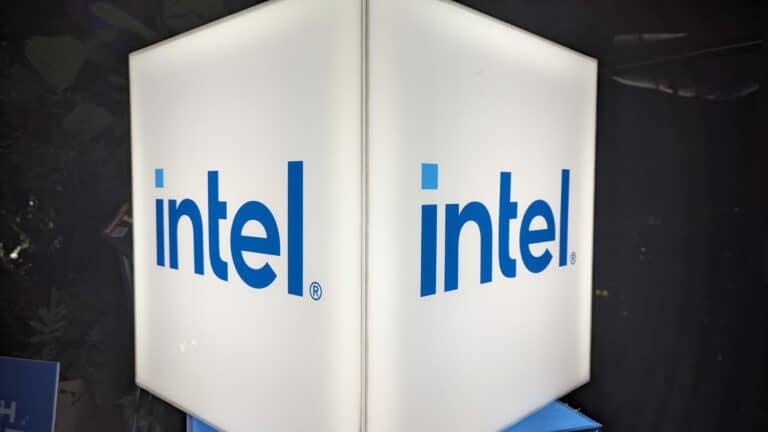Intel is currently considering radical choices. As the only chip company with the ability to design chips as well as manufacture them, a transformation for “Chipzilla” may be approaching. Investors are being presented with strategic plans that have loud echoes of the past.
To put it succinctly: a split between Intel (the chip designer) and Intel Foundry (the chipmaker) is possible. CEO Pat Gelsinger sees this rigorous move as a possibility now that the stock has fallen massively in value. Major stability issues inside client processors, disappointing quarterly results and a major round of layoffs coincided over the past few months. A takeover by activist shareholders cannot be ruled out and Intel has felt compelled to hire lawyers to defend against a hostile takeover. Banks have also been approached to assist with any further strategic shifts.
Intel operates quite separately from the Intel Foundry business unit, while still constituting one company. For a few years now, the two sides have been operating fairly autonomously, with Intel having chip components partially baked by Intel Foundry competitor TSMC. Still, building out Intel Foundry as a full-fledged chipmaker is a process that will take years, perhaps a decade or more. As a result, the company-wide reset that Gelsinger has dubbed “IDM 2.0” may not get the time it requires to fully crystallize. What will the alternative strategy be?
The GlobalFoundries strategy?
In conversations with Intel (as well as Intel Foundry), we have noticed for some time that both business units operate as if the other is an entirely separate company. Intel’s own chip designs remain secret; the techniques used to make them, on the other hand, are fully accessible to others. Microsoft already signed up to have its chips made by Intel, and Nvidia sees Intel Foundry as an interesting option down the road. This need not be surprising, as Intel has been on board early with ASML’s very latest High-NA EUV machines to manufacture on even smaller process nodes.
It is uncertain whether Intel will face that future intact. Following in the footsteps of perennial rival AMD, Intel could well go fabless, i.e. spin off its chip manufacturing division. AMD opted for such a move back in 2008, from which emerged GlobalFoundries, which gradually became an independent entity. Although the first few years thereafter were disappointing for AMD, it has been reborn in recent years with its Zen chip designs. It ultimately stopped doing business with Global foundries entirely, as soon as contractual obligations allowed. Designing chips without making them isn’t really an issue, then. This is proven emphatically by the AI phenomenon of Nvidia, which has never made its own chips.
The contrast between Intel on the one hand and AMD and Nvidia on the other could hardly be greater. Years of underwhelming chip releases were already depressing the stock price of the once supreme company. Today, AMD is worth almost three times as much. If one was to convert Nvidia’s market cap into cash, you’d be able to buy Intel thirty-five times over.
Also read: Tech stock market slumps: AI hype disappoints investors
Doesn’t just happen
Intel’s dire situation didn’t just happen at random. The road to crisis was paved with missed opportunities. Some mistakes occurred years ago: the smartphone revolution of the mid-’00s passed Intel by, rejecting EUV equipment from ASML proved to be disastrous in the decades that followed, and Apple, once Intel’s most lucrative customer by far, walked away to design its own Apple Silicon with enormous success out of the gate.
Miraculously, Intel managed the five nodes in four years promised by Gelsinger, alternating chip production techniques at the pace of an Olympic sprinter. Still, that’s not enough to beat AMD and Nvidia where it counts. Although Intel still leads in the laptop, desktop and server markets, AMD is continually grabbing market share across all markets. Intel’s Gaudi GPUs are also finding less traction than AMD’s Instinct series as a challenger to the ultra-dominant Nvidia, despite a recent deal with IBM.
Mistakes made, but lessons learned
All signs point to Intel having learned from the past. The market is hostile to say the least, especially because the completely sensible-sounding chip production plans just take a very long time to execute on. Obtaining permits and subsidies in the U.S. and Europe is taking longer than desired. Taken as a whole, it’s going to take years before any benefits are realized. The same story applies to the brand-new ASML machines that cost a pretty penny each. They’re still being tested and will only produce advanced chips on a large scale in a few years’ time.
For now, it is up to Intel to make hard choices. It has already done so by cutting 15,000 jobs and divesting several divisions. Still, the elimination of Intel Foundry would be in a completely different league. Intel designed and built the very first microprocessor in the form of the Intel 4004 in the year 1971, when IBM’s Personal Computer was still a decade away. Designing and building chips is in the company’s DNA. Nevertheless, a cultural shift has already occurred, with the foundation of Intel Foundry as its cornerstone. Now, market forces seems to mandate an Intel identity change for good.
In September, the board of directors will consider its options. One thing is certain: Intel must make hard choices that it cannot falter on.
